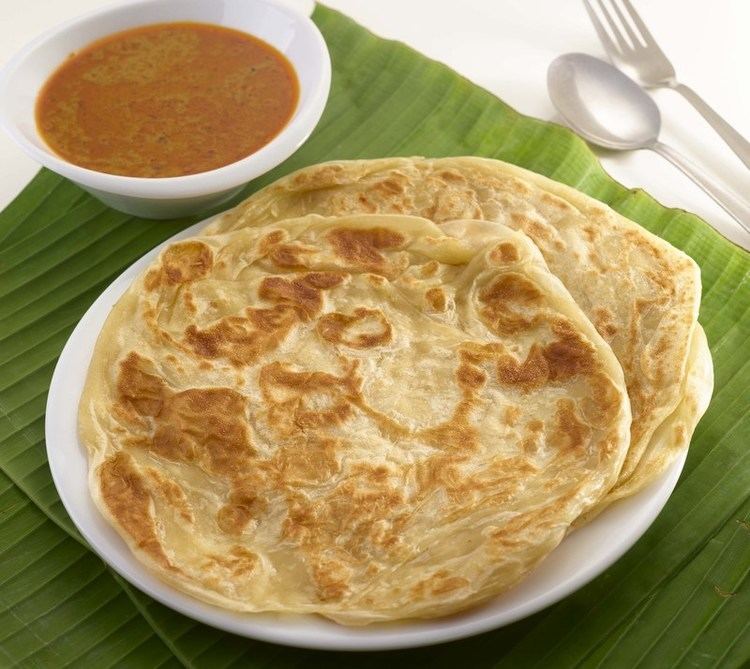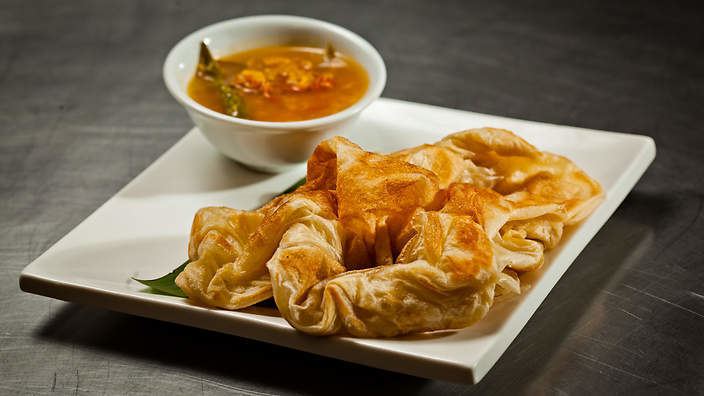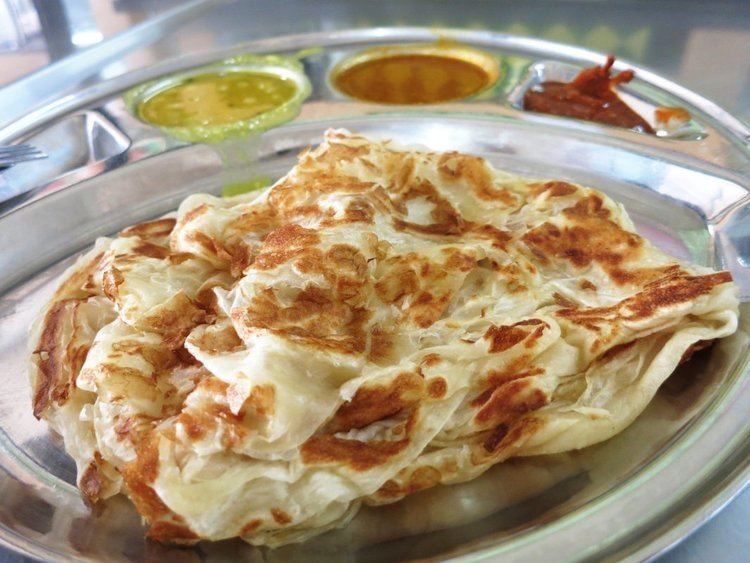Serving temperature Hot Main ingredient Flour | Type Flatbread Main ingredients Flour Variation Paratha | |
 | ||
Similar Roti, Nasi lemak, Teh tarik, Murtabak, Laksa | ||
Malaysian flatbread roti canai erwan heussaff
Roti canai (pronunciation tʃanai) or roti cane (pronunciation tʃane) is a type of Indian-influenced flatbread found in Malaysia, Brunei, Indonesia and Singapore. It is often sold in Mamak stalls in Malaysia; also in Malay, Minangkabau and Aceh restaurants in Indonesia. It is known as roti prata in Southern Malaysia and Singapore, and is similar to the Indian Kerala porotta. It is also found throughout Thailand, where it is called "Ro Tee" and is typically sold by Muslims, most often from street carts, and is usually Halal.
Contents
- Malaysian flatbread roti canai erwan heussaff
- Malaysian flat bread roti canai full recipe hd
- Etymology
- Composition
- Consumption
- Malaysia
- Variations
- Indonesia
- Thailand
- References
In English and in Chinese, roti canai is sometimes referred to as "flying bread" (飞饼 fēibǐng), a term that evokes the process of tossing and spinning by which it is made. In Chinese, Roti canai is originally called 印度煎饼 "yìn dù jiān bǐng", which means Indian pancake.

Traditionally roti canai is served with dhal (lentil curry) or any type of curry, such as mutton or chicken curry. However, the versatility of roti canai as the staple lends itself to many variations, either savoury or sweet, with a variety of toppings and fillings, which includes eggs, banana, sardines and onion. In Thailand, it is usually served sweet - typical fillings include condensed milk, peanut butter, jam and nutella, without the curry.

Malaysian flat bread roti canai full recipe hd
Etymology
Roti means bread in Hindi, Urdu, most other North Indian languages, and Malay. The term "canai" may be derived from:
Composition
The dish is composed of dough containing copious amounts of fat, flour and water. The form of fat used is usually ghee (clarified butter). Some people add sweetened condensed milk to the mix. The entire mixture is kneaded thoroughly, flattened, oiled and folded repeatedly. It is then allowed to proof and rise, and the process is repeated. These days, many restaurants do not prepare the dough themselves, tubs of prepared balls of dough are delivered by truck from a central facility. The final round of preparation consists of flattening the dough ball, spreading it out until paper thin (this is usually done by "tossing" it on a flat surface), and then gathering this thin sheet of dough into a long rope-like mass. This "rope" is then wound into a knot or spiral and then flattened, so the ideal roti consists of thin flakes of dough when cooked, fluffy on the inside and crisp on the outside. Up until the 1970s it was common for cooks to make the "rope" quite long and form a spiral that went around several times (much like the modern "roti bom"), but this is no longer the case, probably because the amount of dough used per roti is about half of what it used to be, and a roti made this way would be only the size of a "roti bom". When making varieties with fillings, however, the fillings (be it egg, chopped onions, etc.) is spread or sprinkled on the thin sheet of dough, which is then folded into a square, trapping the fillings inside.
Consumption
Roti canai commonly is consumed with curries, as a dipping sauce or poured upon the roti. Variations of curries includes lentil, vegetables, mutton, beef to chicken curry. However, as a staple food, the versatility of roti canai has enabled the cook to create some new recipes and derivatives with variations of toppings and fillings, either savoury or sweet. One of the characteristics of roti canai and its derivatives is that it can be eaten with the hands, without the need for utensils. This makes it a convenient dish to consume, while being filling. This characteristic makes it a dish of choice as breakfast or as late night supper.
Malaysia
Roti canai is a favorite breakfast dish in Malaysia. It was said that the food was brought over from India by the Indian Muslims, also known as "Mamaks" in Malaysia. It is ubiquitously available in Mamak stall day and night in almost every urban area in Malaysia, and is among the popular Malaysian Indian cuisine. Despite its Indian-influenced origin, it was said that it is easier to find roti canai in Malaysia rather than in India.
Traditionally, it is served with dal or 'dhal' (lentil) curry, which in North India is prepared with chana dal. There are also a lot of different curries used besides dhal, for example:
It can sometimes be taken with sugar or condensed milk, or sambal tumis. Varieties of roti with fillings have long been available, some are listed below.
Variations
The versatility of roti canai enabled this flatbread to be combined with various ingredients, either savoury or sweet. Generally these more elaborate forms of roti canai are denoted by prefixing roti to the additional ingredient used. Most of the variations listed below are commonly seen on menus, and the ones that are not can often be custom ordered:
Plain roti is often referred to as "roti kosong" (i.e. "empty bread" in Malay).
Most plain roti are round, while those with fillings are square in shape due to the folding of the roti. To save time, many restaurants will keep a stack of pre-made roti in a cooler to keep them warm. Since these might sit for a while and become unpleasantly tough, some consumers might insist on a square roti to ensure they get a freshly prepared one. Some cooks will fluff up the roti by crumpling it by clapping their hands together, forcing the sides of the roti together. Some may serve the roti cut up into squares (murtabak and roti telur are often served like this), and a customer can ask for "roti banjir" (flooded roti) - a roti with lots of curry poured over the top.
Roti canai is inexpensive in Malaysia (the standard price is RM1.20 per piece). It is also available in frozen form whereby pre-fried roti canai is processed through a blast-freezing technique to ensure a soft and fluffy texture upon defrosting and refrying.
Indonesia
In Indonesia, roti canai is often called as "roti cane", "roti konde" or "roti maryam". and usually served with Kari Kambing (mutton curry). It is derived from Indian cuisine and came into Indonesia via the influx of Muslim Indian migration to Aceh Sultanate in Northern parts of Sumatra circa 17th century, and later to the rest of Dutch East Indies in early 19th century. Roti canai is more prevalent in Sumatra, especially in Aceh, North and West Sumatra. Roti cane has been adopted within Malay cuisine of Sumatra, Aceh cuisine, and Minangkabau cuisine. Consequently, there are Malay, Aceh, and Minangkabau restaurants that serve roti canai with mutton curry in Indonesia that are operated by ethnic groups other than Indians. This Indian-origin dish has been well-integrated into Aceh cuisine that it has been considered as theirs.
In Ampel, an Arab quarter in Surabaya, it is known as "roti maryam", while common Javanese called it as "roti konde" after its similar shape to hairbun (Javanese:konde). Despite being called in different names, their recipes is quite identical, and they are influenced by paratha, a flatbread that originated in the Indian subcontinent.
Thailand
In Thailand "roti" or "rotee" or "ro tee" is sold from street carts, usually by Muslims, and is usually halal, usually with signs with prices in English (since tourists make up a large fraction of the customers). Unlike Malaysia, Singapore or Indonesia, variations tend towards the sweet rather than the spicy or savory. Popular variations include mango, banana, sugar, condensed milk, jam, peanut butter and Nutella roti, although Egg Rotee (often with sweet condensed milk spread over the top) is also available. Curries are usually not served. Prices range between 10 and 60 baht. Some stalls sell "mataba" (the equivalent of the Malaysian "murtabak"), though this is usually found in restaurants that sell Indian Muslim food such as Briyani Rice rather than at rotee stalls.
